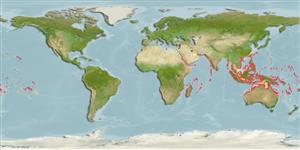Common names from other countries
Environment: milieu / climate zone / depth range / distribution range
Ekologi
Berasosiasi dengan karang; nir-ruaya (Ref. 348); payau; kisaran kedalaman 0 - 35 m (Ref. 348). Tropical; 23°C - 30°C (Ref. 102835); 28°N - 37°S, 31°E - 128°W
Indo-Pacific: Egypt to Pitcairn Islands and Ogasawara, Japan to Lord Howe Island.
Length at first maturity / Size / Weight / umur
Maturity: Lm ?, range 6 - 13 cm Max length : 41.7 cm SHL jantan/; (Ref. 117184); common length : 25.0 cm SHL jantan/; (Ref. 348)
The mantle color is highly variable, ranging from bright blue to brown.
Collected for food and for the shell trade. Aquaculture trials have been done in 1998 (Ref. 348). Maximum depth from Ref. 75831. Found in coral reef flats in shallow areas (Ref. 799), reef areas of lagoons (Ref. 97298) and in intertidal areas (Ref. 75831). Mixotrophic - filter feeds and photosynthesizes via its zooxanthellae (Ref. 105208). Tridacnids derive their nutrition from uptake of dissolved matter through their epidermis and from their symbiotic zooanthella Symbiodinium microadriaticum (Ref. 107098).
Life cycle and mating behavior
Kematangan | Reproduksi, perkembang biakan | Pemijahan | telur-telur | Fecundity | Larva
Life cycle: Embryos develop into free-swimming trocophore larvae, succeeded by the bivalve veliger, resembling a miniature clam (Ref. 833).
rujukan utama
Acuan | Koordinator | mitra
SAUP Database. 2006. (Ref. 356)
Status IUCN Red List (Ref. 130435)
status CITES (Ref. 108899)
Not Evaluated
ancaman kepada manusia
Reports of ciguatera poisoning (Ref. 130160)
penggunaan manusia
Perikanan: komersial
FAO - Budidaya air: production; | FishSource | Sea Around Us
Alat, peralatan
Sumber internet
Estimates based on models
Preferred temperature
(Ref.
115969): 24.8 - 29.3, mean 28.4 (based on 3421 cells).
Daya lenting
sedang, Waktu penggandaan populasi minimum 1.4 - 4.4 tahun (K=0.18-0.28; tm=3.8).
Prior r = 0.49, 95% CL = 0.32 - 0.73, Based on 1 data-limited stock assessment.
keancaman
Low vulnerability (25 of 100).
kategori harga
Unknown.
